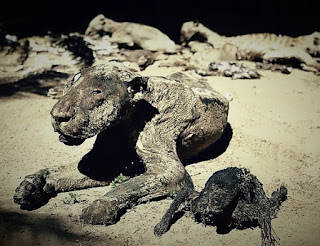Gaza Zoo and Its Sad End
In one of my previous posts I wrote about the Qualqilya zoo, where taxidermy is used to preserve dead animals, many of which had been killed by war, so that they can still be exhibited. Similarly, the city of Gaza and its zoo had been significantly affected by the militant conflict between Israel and Palestine, but the Gaza zoo had suffered to a much greater extent.
The zoo in Gaza opened in 2007 and many of its animals were smuggled accross the Egyptian border to create the initially thriving attraction. However, in 2008 a military offensive was launched by Israel against Hamas, which lasted 3 weeks, and during that time the zoo owner was unable to access the establishment. As a result, many animals starved to death. To preserve them, Mr Awaida (the owner) decided to resort to self-taught taxidermy using formaldehyde and sawdust.
The conditions in the area had not improved since. Due to shortages in funding many of the animals continued starving. As the animals lost during the offensive included zebras, the zoo resorted to painting stripes on donkeys as a replacement. Many of the other animals continued slowly starving to death since, while others were killed by bombs and white phosphorus, which was also used in the warfare. The dead specimens would be preserved afterwards, joining the other stuffed and mummified exhibits. Despite that, the zoo remained as the only local attraction which enabled local children to experience wildlife from other parts of the world.
However, in 2014 the zoo was finally shut to the public. In 2016 the zoo owner began putting the remaining living animals up for sale, as the final attempt to save their lives. The zoo finally closed in 2016 permanently and the remaining animals were moved to rescue centers.
In media the zoo was frequently referred to as "the world's worst zoo" due to the many tragic deaths of its animals and the grotesque experience of viewing their mummified corpses within the facility. However, in reality, this unfortunate institution was merely a reflection of a problem on a much wider scale. The premature deaths of the captive animals were primarily caused by war, despite the attempts of the staff to provide for them. Although the zoo was closed down and animals rescued, this also took away the opportunity to educate local residents about wildlife in other parts of the world. Unlike the Qualqilya zoo, the Gaza zoo can no longer represent a place where strangers can unite by their love of animals. Even though millions of humans and animals will continue dying,
 |
| Mummified animals were displayed as exhibits in the zoo. |
The zoo in Gaza opened in 2007 and many of its animals were smuggled accross the Egyptian border to create the initially thriving attraction. However, in 2008 a military offensive was launched by Israel against Hamas, which lasted 3 weeks, and during that time the zoo owner was unable to access the establishment. As a result, many animals starved to death. To preserve them, Mr Awaida (the owner) decided to resort to self-taught taxidermy using formaldehyde and sawdust.
The conditions in the area had not improved since. Due to shortages in funding many of the animals continued starving. As the animals lost during the offensive included zebras, the zoo resorted to painting stripes on donkeys as a replacement. Many of the other animals continued slowly starving to death since, while others were killed by bombs and white phosphorus, which was also used in the warfare. The dead specimens would be preserved afterwards, joining the other stuffed and mummified exhibits. Despite that, the zoo remained as the only local attraction which enabled local children to experience wildlife from other parts of the world.
However, in 2014 the zoo was finally shut to the public. In 2016 the zoo owner began putting the remaining living animals up for sale, as the final attempt to save their lives. The zoo finally closed in 2016 permanently and the remaining animals were moved to rescue centers.
In media the zoo was frequently referred to as "the world's worst zoo" due to the many tragic deaths of its animals and the grotesque experience of viewing their mummified corpses within the facility. However, in reality, this unfortunate institution was merely a reflection of a problem on a much wider scale. The premature deaths of the captive animals were primarily caused by war, despite the attempts of the staff to provide for them. Although the zoo was closed down and animals rescued, this also took away the opportunity to educate local residents about wildlife in other parts of the world. Unlike the Qualqilya zoo, the Gaza zoo can no longer represent a place where strangers can unite by their love of animals. Even though millions of humans and animals will continue dying,


Comments
Post a Comment